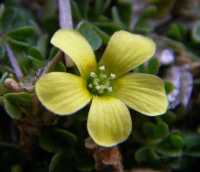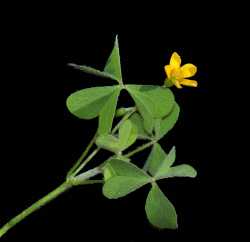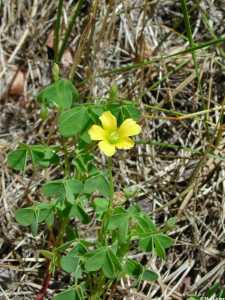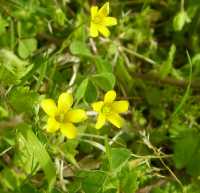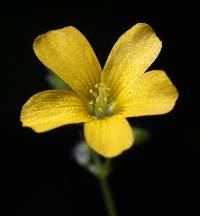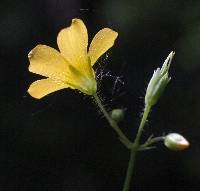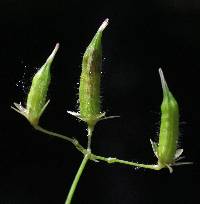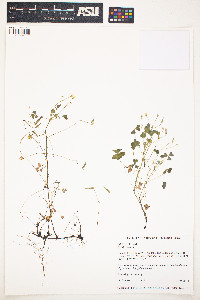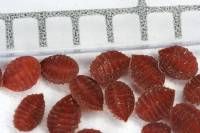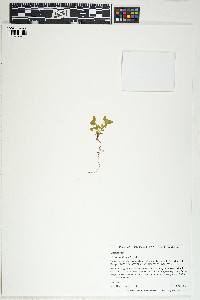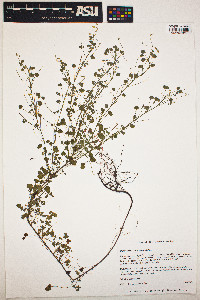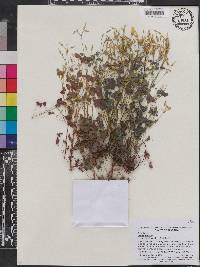|
Family: Oxalidaceae
common yellow oxalis, more...creeping woodsorrel [ Acetosella corniculata (L.) Kuntze, moreOxalis corniculata var. langloisii (Small) Wiegand, Oxalis corniculata var. lupulina (Kunth) Walp., Oxalis corniculata var. macrantha Trel., Oxalis corniculata var. macrophylla Arsène ex R.Knuth, Oxalis corniculata var. minor Laing, Oxalis corniculata var. reptans Laing, Oxalis corniculata var. sericea Kunth, Oxalis corniculata var. villosa (M.Bieb.) Hohen., Oxalis corniculata var. viscidula Wiegand, Oxalis langloisii (Small) B. E.Smith, Oxalis macrantha Small, Oxalis repens Thunb., Oxalis simulans Baker, Oxalis stricta L., Oxalis villosa M. Bieb., Xanthoxalis corniculata (L.) Small, Xanthoxalis corniculata f. atropurpurea (Planch.) Nakai, Xanthoxalis corniculata var. atropurpurea (Planch.) Moldenke, Xanthoxalis langloisii Small, Xanthoxalis macrantha (Trel.) Small] |
Plant: perennial herb; stems prostrate or decumbent, to 30 cm long, often rooting at nodes Leaves: cauline; leaflets 3, to 2 cm long, often maroon INFLORESCENCE: 2-5-flowered; pedicels less than 1 cm long Flowers: perfect, the petals clawed, connate at base; stamens 10; pistil 5-carpelled; styles 5, colollas yellow, 4-8 mm long Fruit: FRUITS fleshy explosive capsules, cylindric, angled, 6-25 mm long. SEEDS 1.2-1.5 mm long, arillate Misc: Common in lawns, gardens, disturbed places, greenhouses, and occasionally woodlands or grasslands:; 250-1300 m (1100-3900 ft); flowers all year REFERENCES: Denton, Melinda. 1998 Oxalidaceae. J. Ariz. - Nev. Acad. Sci. 30(2): 115. Perennial from long slender rhizomes, prostrate to more often erect and to 5 dm; stems pubescent with spreading, blunt-tipped, septate hairs, sometimes also strigose, seldom glabrous; stipules none; lfls 1-2 cm wide, usually glabrous to merely ciliate; peduncles usually exceeding the fls, 2-7-fld; pet 4-9 mm, yellow; fr 8-15 mm, provided with spreading, flexuous, septate hairs; 2n=18-24. Nearly cosmopolitan weed, often in natural habitats as well, probably originally native to N. Amer. Numerous infraspecific taxa are often defined on the distribution and orientation of the hairs. (O. europaea; O. corniculata, misapplied; Xanthoxalis stricta; X. bushii; X. cymosa; X. rufa)
Gleason, Henry A. & Cronquist, Arthur J. 1991. Manual of vascular plants of northeastern United States and adjacent Canada. lxxv + 910 pp.
©The New York Botanical Garden. All rights reserved. Used by permission. Plant: Perennial herb; STEMS usually erect, unbranched, to 75 cm tall Leaves: cauline; leaflets 3, 5-20 mm long, pale green INFLORESCENCE: 1-9, rarely more, 2-5-flowered; pedicels 8-10 cm long Flowers: perfect, the petals clawed, connate at base; stamens 10; pistil 5-carpelled; styles 5, corollas yellow, or orange-yellow, 3.5-11 mm long Fruit: FRUITS fleshy explosive capsules, cylindrical, 8-13 mm long. SEEDS 0.8-1.3 mm long, arillate Misc: Woodlands; 2100-2200 m (6300-6700 ft); Apr-Jul REFERENCES: Denton, Melinda. 1998 Oxalidaceae. J. Ariz. - Nev. Acad. Sci. 30(2): 115. Wiggins 1964, Ornduff and Denton 1998 Duration: Perennial Nativity: Native Lifeform: Forb/Herb General: Delicate perennial, fleshy taproot, creeping stems that root at nodes, less than 30 cm long, more or less hairy. Leaves: Cauline, petiole less than 7 cm, leaflets less than 2 cm, often maroon. Flowers: Cyme, 2-5 flowered, pedicel less than 1 cm; sepals less than 4.5 mm, petals less than 8 mm, yellow. Fruits: Explosively dehiscent capsule, cylindric, 6-25 mm. Ecology: Found in disturbed spaces, occasionally in grasslands or woodlands from 1,000-4,000 ft (305-1219 m), flowers throughout the year. Notes: Naturalized weed usually found in disturbed areas. Ethnobotany: Taken as an infusion for hookworms, to stop vomiting, as a blood medicine, for mouth aid, sore throat, and as a food. Etymology: Oxalis is from Greek oxys for sharp, sour, and corniculata means horned. � Synonyms: Oxalis albicans, others see Tropicos Editor: SBuckley, 2010 |


